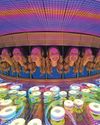CATEGORIES
Kategorien

Mathematicians declare a new class of shape
Not like your typical circle or square, the flexible 'soft cell' is seen throughout nature

COULD MARINE CLOUD BRIGHTENING HELP US FIGHT CLIMATE CHANGE?
The theory behind marine cloud brightening is that brighter or whiter clouds reflect more sunlight back into space.

GHOST DETECTOR
Currently under construction, the Jiangmen Underground Neutrino Observatory (JUNO) is set to unlock the secrets of nature's most elusive subatomic particle: the neutrino. It may ultimately provide the missing pieces of the unified 'Theory of Everything'

Food processing isn't necessarily a bad thing
Using chemicals to alter food doesn't automatically make it bad for you. In some cases, it actually makes the food better

IS IT SAFE TO RUN EVERY DAY, OR SHOULD I DITCH MY RUN STREAK TO SAVE MY KNEES?
A running streak, where you run every day without taking rest days, can be highly motivating and beneficial for overall fitness. Running is great cardiovascular exercise and isn't to be discouraged (and finding a routine with some consistency is great). Getting a bit of exercise as often as possible is also hugely beneficial for your mental health.

HOW CAN I TELL IF I'VE GOT HIGH CORTISOL LEVELS?
Cortisol is a hormone produced by glands in our bodies called the adrenal glands, which sit above the kidneys. It plays a critical role in various bodily functions, including regulating metabolism, reducing inflammation and helping the body respond to stress. While essential for our health, chronic elevation of cortisol levels can lead to several issues.

WHAT IS MEXICO'S BLUE HOLE?
The world's deepest blue hole (marine sinkhole) lies off the coast of Mexico's Yucatán Peninsula. It's at least 420m (1,378ft) deep, but explorers still haven't found its bottom.

DAMAGE ASSESSMENT
Could we deflect an asteroid to stop it from hitting Earth? The success of NASA's DART mission suggests so, but only after ESA's soon-to-launch Hera mission has checked the results will we know if this approach to planetary defence is a viable possibility

KEEP YOUR HAIR ON
MORE THAN HALF OF MEN AND MILLIONS OF WOMEN ARE AFFECTED BY HAIR LOSS. IT CAUSES LOW SELF-ESTEEM IN SOME AND ANXIETY IN OTHERS. THANKFULLY, SCIENTISTS AROUND THE WORLD ARE GETTING TO THE ROOTS OF THE PROBLEM WITH PIONEERING NEW TREATMENTS

Satellite collisions are a disaster waiting to happen, experts warn
With satellites old and new orbiting alongside each other, serious crashes are inevitable

Unseen engineers have been secretly shaping life on Earth, says new research
Recently published studies suggest insects play a much larger role in seed dispersal than previously thought.

Olive mill wastewater: a health-boosting tonic hiding in the leftovers
A by-product of the olive oil production process is packed with compounds that lower your cholesterol and reduce your risk of developing cancer.

COULD ARTIFICIAL INTELLIGENCE BE THE CURE FOR LONELINESS?
Rates of loneliness are increasing worldwide. But big-tech companies think they have the solution...

SAVE THE SHARKS...SAVE THE OCEANS
RUTHLESS PREDATORS, MINDLESS KILLERS, MAN-EATERS... SHARKS HAVE A FEARSOME REPUTATION THAT BEARS LITTLE RELATION TO REALITY. THE TRUTH IS, THESE REMARKABLE CREATURES ARE STRUGGLING TO SURVIVE. BUT OUR WATERS WON'T BE ANY SAFER WITHOUT THEM. IN FACT, THE PLANET'S SEAS WILL BE IN EVEN GREATER JEOPARDY THAN THEY ALREADY ARE

Lab-grown meat may be better for livestock, but not necessarily for the environment
The move to put alternative protein on our plates is gathering pace but there are still questions to answer

What tipping point are climate scientists most worried about?
Collapsing ice sheets, loss of the Amazon rainforest, melting permafrost.……. Key parts of Earth's climate system are in trouble. Which could trigger disaster first?

WHEN'S THE BEST TIME FOR A CAFFEINE HIT?
Wakey-wakey! Find the sweet spot for a coffee shot and science says the benefits are grande

PROFESSOR BRIAN COX
The biggest space missions yet are making their way to new parts of the Universe. In his new BBC Two series Solar System, Prof Brian Cox reveals what these explorations are discovering about life in our galactic neighbourhood. Noa Leach sat down with him to talk about the most exciting new missions, life in the Universe and his top behind-the-scenes moments of filming

DEAD MAN’S FINGERS
Picture the scene. It's Halloween and you've gone for an ill-advised stroll through the graveyard on the edge of town.

Tiny bug sets record for the fastest backflips on Earth
The insect somersaults so quickly that it seems to disappear

New Ozempic-like pill cuts weight by 13 per cent
A new weight-loss drug's effects could rival the current injection-only medication.

The botanists studying plants from the sky
Scientists are working with paramotorists to find rare flowers in the desert

SMASH STEREOTYPES
In an extract from his prize-winning book, scientist and writer Adam Rutherford shows you how to use the power of science to fight racism. This chapter, titled Myth-Busting, is all about sport.

MANCHESTER SCIENCE FESTIVAL
From 18-27 October, shoppers at the Arndale shopping centre in Manchester, England, will face a giant spider.

Are ghosts real?
Plenty of people believe in ghosts, but it's hard to find proof.

Camera Obscura
Imagine stepping inside a dark room, where the only source of light comes through one small hole in the wall.

Sunflowers work as a team to share sunlight
Research has found that sunflowers move to avoid blocking each other's sunlight.

Teenager spots rare moth's eggs in UK
A teenager who became the first person to find the eggs of a rare moth in the UK has been nominated for a national award.

First private spacewalk
On 12 September, billionaire Jared Isaacman completed the first-ever spacewalk by a nonprofessional astronaut.

Bat-like robot clings to tree
Researchers have developed a special robot that can fly into trees and cling on.